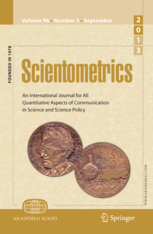A series of ISSEK-authored papers published in Scientometrics
In 2017 a leading international journal in the field, Scientometrics, published six papers by staff members of the HSE Institute for Statistical Studies and Economics of Knowledge describing application of various sociology of science and Foresight techniques for the purposes of studying driving forces and directions of scientific development.
About the journal
Scientometrics publishes papers on methodological approaches to studying research-related mechanisms and trends, and results of relevant quantitative studies .
Publishers: Akadémiai Kiadó and Springer Science+Business Media.
Published continuously since 1978. Indexed in Scopus science citation database.
ISSN: 0138-9130 (printed version) 1588-2861 (online version)
Website: https://link.springer.com/journal/11192
Below are brief abstracts of each of the six articles; some of them we’ll present in more detail in our future publications.
How the analysis of transitionary references in knowledge networks and their centrality characteristics helps in understanding the genesis of growing technology areas
Konstantin Fursov and Alina Kadyrova study emergence of, and development trends in new technology areas related to social sciences during the previous 60 years, applying analysis of co-citation networks and the so-called transitionary references to large volumes of data. This approach allowed them to identify and monitor emerging and advanced technologies since the very early stages of their development.
Published in June 2017, Volume 111, Issue 3, pp 1947–1963.
First online publication: 14 March, 2017.
Trend monitoring for linking science and strategy
Pavel Bakhtin, Ozcan Saritas, Alexander Chulok, Ilya Kuzminov, and Anton Timofeyev presented iFora — a system for smart analysis of big data designed by the HSE Foresight Centre to support strategic decision-making. Using several industries as examples, they demonstrate how the system can be applied to monitor global technology trends and support S&T Foresight sturdies .
Published in June 2017, Volume 111, Issue 3, pp 2059–2075.
First online publication: 20 March, 2017.
Evolution of connected health: a network perspective
Ozcan Saritas together with several researchers from the Izmir Kâtip Çelebi University (Turkey) have analysed the steadily strengthening links between the health sphere and ICT, and the evolution of relationship between these two knowledge areas in particular, through a scientometric analysis of search requests in the Web of Science citation database.
Published in September 2017, Volume 112, Issue 3, pp 1419–1438.
First online publication: 15 June, 2017.
Measuring, analysis and visualization of research capacity of university at the level of departments and staff members
Maxim Kotsemir and Sergey Shashnov show how one can measure various aspects of publication activity of a university, its departments, and individual faculty members, using simple and clear techniques and data visualisation methods. The suggested approaches can be easily reproduced for the purposes of monitoring universities’ publication activity.
Published in September 2017, Volume 112, Issue 3, pp 1659–1689.
First online publication: 26 June 2017.
The «space of physics journals»: topological structure and the Journal Impact Factor
Yuri Kachanov and Julia Markova (the American Association for the Advancement of Science) assess the influence of 240 physics magazines indexed in the Web of Science citation database. The authors present the body of printed magazines as a topological space of citation distribution empirical functions, and compare the results they have calculated for various magazines. The paper shows that the space of physics publishers is structured by two fundamental juxtapositions. In the first case it’s global publishers against local ones; in the second, professional scientific communities of predominantly US origins are compared with commercial publishers with mostly European roots.
No planned publication date is indicated for the journal yet.
First online publication: 24 July 2017.
Internal migration of scientists in Russia and the USA: the case of physicists
Ekaterina Dyachenko studies researchers’ mobility — one of the major mechanisms of knowledge dynamics. When researchers change jobs they bring their experience, connections, and accumulated tacit knowledge with them. The paper compares structures of domestic migration of Russian and American physicists. If we are interested in mobility as a knowledge transfer mechanism, we should pay attention not just to its overall level (how many researchers move from one place to another), but also to its spatial structure. The study uses a small sample and is exploratory in nature. Data on researchers’ jobs was taken from the Web of Science. On the basis of comparing the two networks the author suggests several hypotheses on how specific features of mobility can affect countries’ overall research productivity.
No planned publication date is indicated for the journal yet.
First online publication 31 July 2017.
By Maxim Kotsemir

